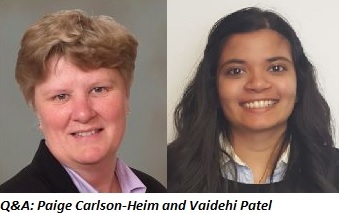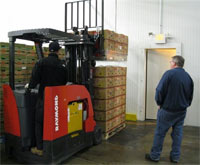NACEDA Intern Vaidehi Patel spoke with Paige Carlson-Heim of TD Bank about the Community Reinvestment Act.
April 28, 2016
 I came into this internship at NACEDA knowing very little about community development. Despite economics being my major, I had only been exposed to the mathematical understanding of the concepts. Through my classes, I picked up a particular interest in the world of banking and financial economics. I am fascinated by the inner workings of a bank, but I had only ever been exposed to the operational duties of the bank. The balance between assets and liabilities and analyzing their financial statements to perceive risky behavior was the crux of my knowledge.
I came into this internship at NACEDA knowing very little about community development. Despite economics being my major, I had only been exposed to the mathematical understanding of the concepts. Through my classes, I picked up a particular interest in the world of banking and financial economics. I am fascinated by the inner workings of a bank, but I had only ever been exposed to the operational duties of the bank. The balance between assets and liabilities and analyzing their financial statements to perceive risky behavior was the crux of my knowledge.
During this internship, I was introduced to the Community Reinvestment Act (CRA), passed in 1977 to encourage banks to meet the borrowing needs of low- and moderate-income households in their neighborhoods. While my research into the act showcased simple definitions, it did not provide me with the answer of how it relates back to community developers. So, I decided to go straight to the source, a CRA Officer.
Paige Carlson-Heim is the Community Development Manager at TD Bank and a NACEDA board member. Talking to Paige, I learned about the importance of building relationships between banks and development organizations.
Here’s our conversation.
Q: How did you get into your current position at TD Bank?
A: I was working at the Housing and Community Development Network of New Jersey. I was very involved in negotiating CRA agreements with banks in partnership with another organization called New Jersey Citizen Action. Together we would meet with banks and work out these agreements. In the course of doing that work, I met the individual who eventually hired me at TD Bank. I liked what the bank was doing for the community and decided to give it a try.
Q: What are some new trends that you’re seeing?
A: Since the late 2000s after the financial crisis, the whole world changed. Financial institutions tightened up their credit a lot and that made it harder for people to borrow. There’s also a lot more regulation, which is not always a bad thing. We definitely haven’t solved all the problems yet. The people impacted most by the financial crisis were low- and moderate-income people and that continues to be the case.
Another huge trend is a significant increase in borrowing for education.I see people who can’t afford to buy a house or to take out money to start a small business because they are saddled with student debt. They may never get out of under it. In my opinion, we’re not dealing with student debt enough on the front end. We require counseling to get a house; you should have to get counseling to get a student loan. We’re struggling to get in on the front end to educate people before they sign on the dotted line.
An exciting trend in community development is the whole linkage around health institutions with housing and other community development needs. I have a personal interest in it but also, as an investor, I’m seeing community health centers open up to address a lot more than just health needs. I am fascinated by the topic.
Q: What’s an investment that excited you the most?
A: A recent investment we made was in Baltimore. We did not have a lot of “stores”, TD branches, in Baltimore. We had a lot of locations all around the city but about 18 months ago we opened a store in the city. The regulators came to us and said the city is the "hole in the doughnut" in terms of TD's provision of banking services -- Baltimore is within the region and has needs you should address. So, TD Bank partnered with The Reinvestment Fund (TRF) out of Philadelphia that has a partnership with some local churches in Baltimore. Over the last year-and-a-half, we have been working with them in different phases, to finance the renovation and new construction of the East Baltimore neighborhood. TRF and its partners are changing the market there block by block. It’s really remarkable, those folks on the ground are really bringing this community back.
So, TD Bank partnered with The Reinvestment Fund (TRF) out of Philadelphia that has a partnership with some local churches in Baltimore. Over the last year-and-a-half, we have been working with them in different phases, to finance the renovation and new construction of the East Baltimore neighborhood. TRF and its partners are changing the market there block by block. It’s really remarkable, those folks on the ground are really bringing this community back.
Q: What’s something that you funded that people might be surprised to know you funded?
A: I think the fact that we fund NACEDA may actually be surprising to people. I bought NACEDA to TD when I first started six years ago and I think sometimes in the funding community, foundations don’t get associations. They want to follow the strict funding rules. I asked my manager to fund NACEDA and said that if you want to get on the ground and understand community development, this is who you have to partner with. I think that people would be surprised because not many investors fund associations. I’m able to do this because of where I originally came from. I worked with these organizations and that’s why I am able to persuade people. In fact, most of my peers are not bankers, we came from the field.
Q: How do you feel about being on the NACEDA Board?
It is a privilege to serve on the board of NACEDA, and one I don't take lightly. I believe that the NACEDA members created the organization to fill a void; to work for and help them. To that end they need the organization to work for them, and they need it's leaders to understand this and to take this responsibility seriously. That they would entrust a bank employee with this responsibility probably didn't come easily, so I take it seriously and try to honor that in my role as a board member. Finally, I love the opportunity serving on the he board offers me to keep learning about the latest trends and innovations in community economic development.
Q: Do you have any advice for grassroots community developers and associations looking for funding?
A: Don’t call us up and ask us for some CRA funding or CRA money. That’s not a good approach. I don’t have any "CRA money". When you approach a bank for grant funding or a loan, tell us about your program or project and how we can partner together. The foundation funds something because its good business and we want a good program. We want to know if it makes sense for us to do business with you and/or to partner with you.
Q: TD Bank is required to make investments where it has branches. But sometimes the available investments in a given geography may not have as much impact as in other geographic areas. How does TD Bank balance the geography and impact of its investments?
A: For a variety of reasons, there may not be the opportunity we’re looking for in a given geography where we’re doing business. One reason could be that there just aren’t that many opportunities in a particular geography or that there is a lot of competition for what opportunities are there. And we might not win every time. For example, in Delaware it sometimes seems as though every bank in America has a location. And while there are plenty of lending and investment opportunities, there are not always enough for every bank
Also, the banks cannot sacrifice safety and soundness for CRA. We’re not going to make a loan or give grant in a situation where we know we’re not going to get paid back, or if we have information to indicate that the organization is unlikely to be successful in carrying out the program. We won’t do an investment on such bad terms that it doesn’t meet safety and soundness requirement from a credit perspective. There’s a balancing act there.
We also try to remain innovative, to try put out products and services that are unique and will attract business to us to get around the competition that way. But obviously, we want to stay active within the geography. In the exam period we want to at least meet the minimum requirements within the geography.
Sometimes, we can also work with partners like CDFIs, a lending situation where we’re looking for an opportunity in a geography but there are lending opportunities that don’t quite meet up to your risk profile. We can then partner with a CDFI who’s got a higher risk tolerance than banks. We invest in that CDFI to meet the lending needs in that geography. We can then help build the customers’ business and their credit and eventually they can borrow directly from us.
Reflections
After this conversation with Paige, I learned a lot about the importance of relationship building and the partnership that exists between borrowers and lenders. As both the financial sector and the community development field continue to grow, it is important to find a happy medium in which interests of both parties can be met. While my academic knowledge has been purely mechanical, this conversation has sparked my interest in the CRA field. Combining the world of banking along with seeking out real ways of helping the community seems like a pretty great career option for the future.
